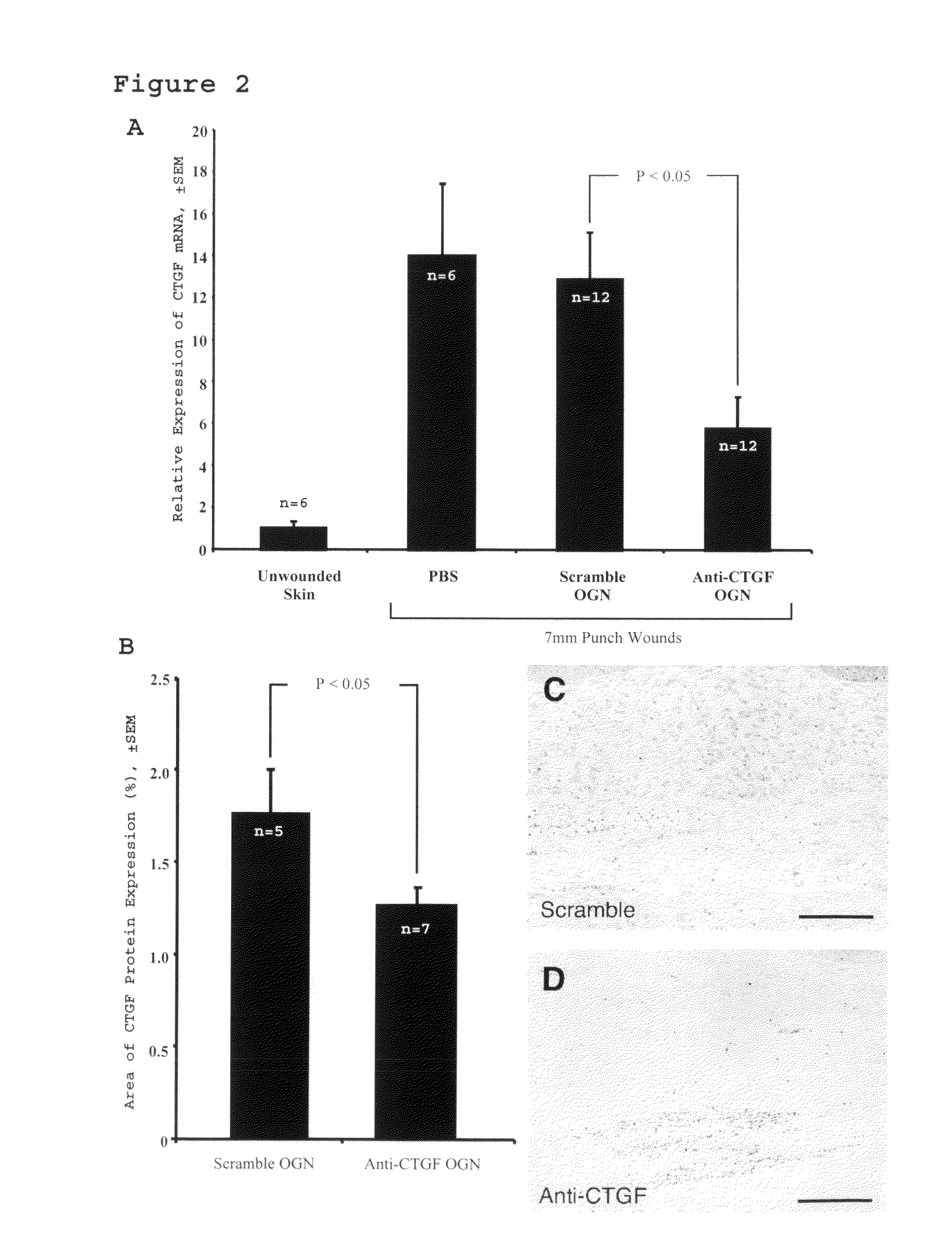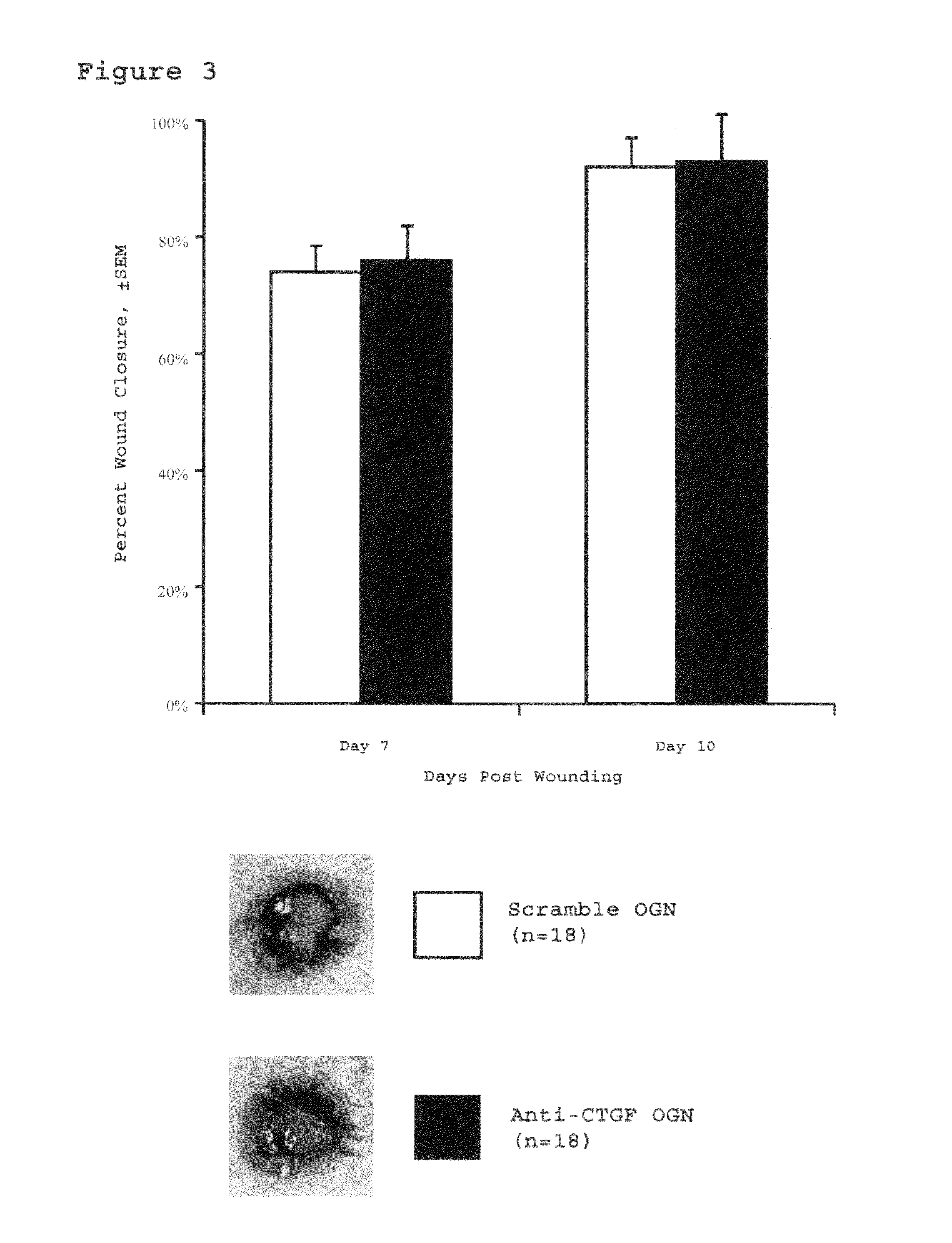Method for reducing scarring during wound healing using antisense compounds directed to CTGF
a technology of antisense compounds and wound healing, applied in the field of scarring reduction, can solve the problems of limited efficacy, lack of defined mechanism of action of most treatment modalities, and reestablish skin integrity, and achieve the effects of reducing hypertropic scarring, inhibiting the expression of ctgf, and reducing hypertrophic scarring
- Summary
- Abstract
- Description
- Claims
- Application Information
AI Technical Summary
Benefits of technology
Problems solved by technology
Method used
Image
Examples
example 1
Antisense Inhibition of Connective Tissue Growth Factors (CTGF / CCN2) mRNA Limits Hypertrophic Scarring Without Affecting Wound Healing In Vivo
[0060]Introduction
[0061]This study assesses the importance of CTGF to wound repair and hypertrophic scarring and evaluate its suitability as a target for anti-scarring therapies. The data demonstrate that modified antisense oligonucleotides against CTGF reduce hypertrophic scarring in an animal (rabbit) model.
[0062]Materials and Methods
[0063]Preparing Antisense Oligonucleotides to CTGF
[0064]Human, mouse, and rat CTGF cDNA were analyzed for unique 20-mer nucleotide sequences with highGC contents to minimize self-hybridization and provide stability of the oligonucleotide mRNA complex. Twenty-mer phosphorothioate oligonucleotides containing 2′-O-methoxyethyl (2′MOE) modifications at positions 1-5 and 15-20, and oligonucleotides at positions 6-14 were used for all experiments. For each gene target, a series of 36 different antisense oligonucleotid...
example 2
Antisense Inhibition of Connective Tissue Growth Factors (CTGF / CCN2) mRNA Limits Hypertrophic Scarring Combined Experiment
[0117]Materials and Methods
[0118]Creating Wounds
[0119]Four circular punch wounds were made on the ears of white New Zealand rabbits as previously described. These wounds were made to the level of the ear cartilage. An operating microscope was used to ensure complete removal of the epidermis, dermis, and perichondrium from each wound, such that a cartilage-based ulcer remained. six-millimeter wounds were created to assess early wound healing kinetics in the wound-healing cohort. Seven-millimeter wounds were created to evaluate scar hypertrophy in the scar cohort. Each wound was individually dressed with a sterile occlusive dressing (Tegaderm, 3M, St. Paul, Minn.) in order to prevent desiccation and cartilage necrosis. The integrity of the dressings and the condition of the wounds were checked daily.
[0120]Administering ASO
[0121]Antisense oligonucleotides were injec...
PUM
| Property | Measurement | Unit |
|---|---|---|
| Tm | aaaaa | aaaaa |
| concentration | aaaaa | aaaaa |
| volume | aaaaa | aaaaa |
Abstract
Description
Claims
Application Information
 Login to View More
Login to View More - R&D
- Intellectual Property
- Life Sciences
- Materials
- Tech Scout
- Unparalleled Data Quality
- Higher Quality Content
- 60% Fewer Hallucinations
Browse by: Latest US Patents, China's latest patents, Technical Efficacy Thesaurus, Application Domain, Technology Topic, Popular Technical Reports.
© 2025 PatSnap. All rights reserved.Legal|Privacy policy|Modern Slavery Act Transparency Statement|Sitemap|About US| Contact US: help@patsnap.com



